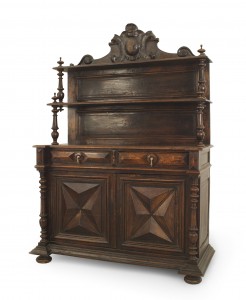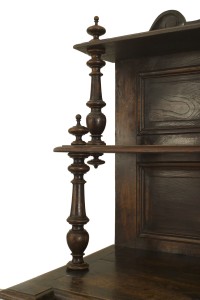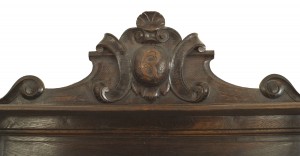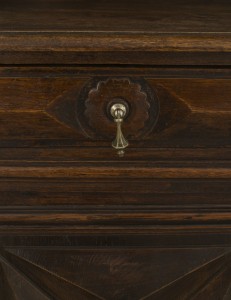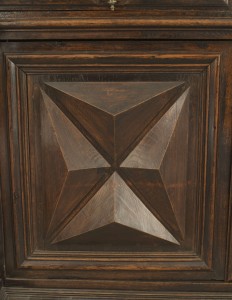English Renaissance Walnut Hutch Cabinet
$24,000 (USD)
Available Qty: 1
Item #: HUR045
English Renaissance-style (18/19th Century) walnut hutch cabinet with 2 shelves under a carved pediment top with 2 drawers over 2 diamond carved doors on the base.
Ships from:
Newel Warehouse
32-00 Skillman Ave
Long Island City NY - 11101
Taxes may apply.
Learn more
See it in Person
Call (212) 758-1970 or Email Us
English Renaissance Walnut Hutch Cabinet
Need Assistance?
Call us at 212-758-1970 for assistance With made to order items
Special Order Terms & Conditions
50% due on approval. 50% upon completion Of production. Please refer to Newel's company policies
INQUIRE
PLEASE FILL IN THE REQUIRED FIELDS.
X
English Renaissance Walnut Hutch Cabinet
English Renaissance-style (18/19th Century) walnut hutch cabinet with 2 shelves under a carved pediment top with 2 drawers over 2 diamond carved doors on the base
DETAILS
Sku:
HUR045
Ships From:
New York, NY
Creation Date:
19th Century
DIMENSIONS (INCHES)
Width:
57.0"
Height:
80.0"
Depth :
24.0"
INFO
Style:
English
Materials & Techniques:
Carved, pediment, walnut
Category:
Cabinets & Case Goods
Good; Wear consistent with age and use
related items
English Renaissance Style Stained Oak Armoire
$16,750
(USD)
QTY: 1
#033192B
Width: 38.5"
Depth: 15"
Height: 78"
Save to project
American Country Style Provincial Farmhouse Hutch
$5,800
(USD)
QTY: 1
#063309
Width: 57.25"
Depth: 14.5"
Height: 75.75"
Save to project
English Regency Brass Inlaid Rosewood Side Cabinet
$12,750
(USD)
QTY: 1
#062866
Width: 41.5"
Depth: 18.5"
Height: 34"
Save to project
English Regency Mahogany Breakfront Cabinet
$38,500
(USD)
QTY: 1
#NWL0712
Width: 99"
Depth: 24"
Height: 97"
Save to project
English Country Walnut Hutch
$22,500
(USD)
QTY: 1
#HUR012
Width: 71.5"
Depth: 18"
Height: 84"
Save to project
American Country Style Provincial Farmhouse Hutch
$5,800
(USD)
QTY: 1
#063309
Width: 57.25"
Depth: 14.5"
Height: 75.75"
Save to project
English Regency Brass Inlaid Rosewood Side Cabinet
$12,750
(USD)
QTY: 1
#062866
Width: 41.5"
Depth: 18.5"
Height: 34"
Save to project
American Country Style Provincial Farmhouse Hutch
$5,800
(USD)
QTY: 1
#063309
Width: 57.25"
Depth: 14.5"
Height: 75.75"
Save to project
English Regency Brass Inlaid Rosewood Side Cabinet
$12,750
(USD)
QTY: 1
#062866
Width: 41.5"
Depth: 18.5"
Height: 34"
Save to project
English Regency Mahogany Breakfront Cabinet
$38,500
(USD)
QTY: 1
#NWL0712
Width: 99"
Depth: 24"
Height: 97"
Save to project
English Country Walnut Hutch
$22,500
(USD)
QTY: 1
#HUR012
Width: 71.5"
Depth: 18"
Height: 84"
Save to project
English Renaissance Style Stained Oak Armoire
$16,750
(USD)
QTY: 1
#033192B
Width: 38.5"
Depth: 15"
Height: 78"
Save to project
American Country Style Provincial Farmhouse Hutch
$5,800
(USD)
QTY: 1
#063309
Width: 57.25"
Depth: 14.5"
Height: 75.75"
Save to project
English Regency Brass Inlaid Rosewood Side Cabinet
$12,750
(USD)
QTY: 1
#062866
Width: 41.5"
Depth: 18.5"
Height: 34"
Save to project
English Regency Brass Inlaid Rosewood Side Cabinet
$12,750
(USD)
QTY: 1
#062866
Width: 41.5"
Depth: 18.5"
Height: 34"
Save to project
English Regency Mahogany Breakfront Cabinet
$38,500
(USD)
QTY: 1
#NWL0712
Width: 99"
Depth: 24"
Height: 97"
Save to project
English Country Walnut Hutch
$22,500
(USD)
QTY: 1
#HUR012
Width: 71.5"
Depth: 18"
Height: 84"
Save to project
English Renaissance Style Stained Oak Armoire
$16,750
(USD)
QTY: 1
#033192B
Width: 38.5"
Depth: 15"
Height: 78"
Save to project
American Country Style Provincial Farmhouse Hutch
$5,800
(USD)
QTY: 1
#063309
Width: 57.25"
Depth: 14.5"
Height: 75.75"
Save to project
English Regency Brass Inlaid Rosewood Side Cabinet
$12,750
(USD)
QTY: 1
#062866
Width: 41.5"
Depth: 18.5"
Height: 34"
Save to project
English Regency Mahogany Breakfront Cabinet
$38,500
(USD)
QTY: 1
#NWL0712
Width: 99"
Depth: 24"
Height: 97"
Save to project
English Regency Mahogany Breakfront Cabinet
$38,500
(USD)
QTY: 1
#NWL0712
Width: 99"
Depth: 24"
Height: 97"
Save to project
English Country Walnut Hutch
$22,500
(USD)
QTY: 1
#HUR012
Width: 71.5"
Depth: 18"
Height: 84"
Save to project
English Renaissance Style Stained Oak Armoire
$16,750
(USD)
QTY: 1
#033192B
Width: 38.5"
Depth: 15"
Height: 78"
Save to project
American Country Style Provincial Farmhouse Hutch
$5,800
(USD)
QTY: 1
#063309
Width: 57.25"
Depth: 14.5"
Height: 75.75"
Save to project
English Regency Brass Inlaid Rosewood Side Cabinet
$12,750
(USD)
QTY: 1
#062866
Width: 41.5"
Depth: 18.5"
Height: 34"
Save to project
English Regency Mahogany Breakfront Cabinet
$38,500
(USD)
QTY: 1
#NWL0712
Width: 99"
Depth: 24"
Height: 97"
Save to project
English Country Walnut Hutch
$22,500
(USD)
QTY: 1
#HUR012
Width: 71.5"
Depth: 18"
Height: 84"
Save to project
English Country Walnut Hutch
$22,500
(USD)
QTY: 1
#HUR012
Width: 71.5"
Depth: 18"
Height: 84"
Save to project
English Renaissance Style Stained Oak Armoire
$16,750
(USD)
QTY: 1
#033192B
Width: 38.5"
Depth: 15"
Height: 78"
Save to project
American Country Style Provincial Farmhouse Hutch
$5,800
(USD)
QTY: 1
#063309
Width: 57.25"
Depth: 14.5"
Height: 75.75"
Save to project
English Regency Brass Inlaid Rosewood Side Cabinet
$12,750
(USD)
QTY: 1
#062866
Width: 41.5"
Depth: 18.5"
Height: 34"
Save to project
English Regency Mahogany Breakfront Cabinet
$38,500
(USD)
QTY: 1
#NWL0712
Width: 99"
Depth: 24"
Height: 97"
Save to project
English Country Walnut Hutch
$22,500
(USD)
QTY: 1
#HUR012
Width: 71.5"
Depth: 18"
Height: 84"
Save to project
English Renaissance Style Stained Oak Armoire
$16,750
(USD)
QTY: 1
#033192B
Width: 38.5"
Depth: 15"
Height: 78"

